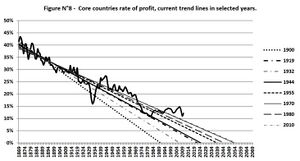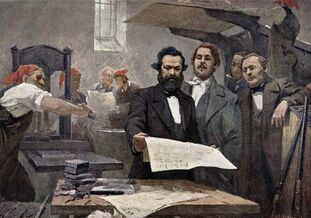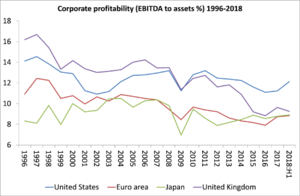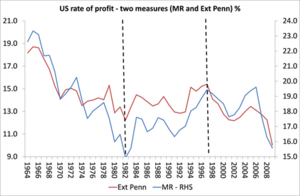Tendency of the rate of profit to fall
"Fundamentals of Marx: Falling Profit Rates" by The Marxist Project |

The tendency of the rate of profit to fall (TRPF) was a law concerning the rate of profit expounded by Karl Marx in chapter 13 of Das Kapital, Volume 3. Marx called this tendency "the most important law of political economy".
Marx argued that increased investment in constant capital (factories, machines, land, buildings, raw materials) relative to variable capital (labor) reduced the margin of surplus labor time relative to the total capital invested (constant capital plus variable capital). According to Marx, surplus labor time is the source of surplus value. Now the rate of profit equals surplus value divided by total capital, so the fall in surplus labor time relative to capital results in a fall in the rate of profit for newly produced commodities.[1]
Even as investment in constant capital increases productivity (i.e. the margin of surplus labor relative to regular labor, and thus of surplus value relative to variable capital), it reduces the rate of profit (i.e. the ratio of surplus value relative to total capital). The capitalist then responds by investing more in raising productivity or expanding the scale of production, which in turn reduces profits per unit further after a while, and so on and so forth, in a vicious cycle of diminishing returns.
This is, then, the general tendency in capitalism, but it is only a tendency, because there are also "counteracting factors" operating which had to be studied also. In his draft manuscript (he did not publish it himself), Marx cited six of them:
- more intense exploitation of labour (raising the rate of exploitation);
- reduction of wages below the value of labour power (commonly referred to as the "immiseration thesis");
- cheapening the elements of constant capital by various means;
- the growth and utilization of a relative surplus population (the reserve army of labour);
- foreign trade reducing the cost of industrial inputs and consumer goods; and
- the increase in share capital, which devolves part of the costs of using capital on others.
"The progressive tendency of the general rate of profit to fall is, therefore, just an expression peculiar to the capitalist mode of production of the progressive development of the social productivity of labour. This does not mean to say that the rate of profit may not fall temporarily for other reasons. But proceeding from the nature of the capitalist mode of production, it is thereby proved a logical necessity that in its development the general average rate of surplus-value must express itself in a falling general rate of profit. Since the mass of the employed living labour is continually on the decline as compared to the mass of materialised labour set in motion by it, i.e., to the productively consumed means of production, it follows that the portion of living labour, unpaid and congealed in surplus-value, must also be continually on the decrease compared to the amount of value represented by the invested total capital. Since the ratio of the mass of surplus-value to the value of the invested total capital forms the rate of profit, this rate must constantly fall.[2]"
References
- ↑ Marx, Karl, Capital, vol. 3, edited by Frederick Engels. New York: International Publishers, 1967 (orig. ed. 1894). Chapter 2, "The Rate of Profit", and chapter 13, "The Law as Such".
- ↑ (Karl Marx, Capital, vol. 3, chapter 13) - http://www.marxists.org/archive/marx/works/1894-c3/ch13.htm


